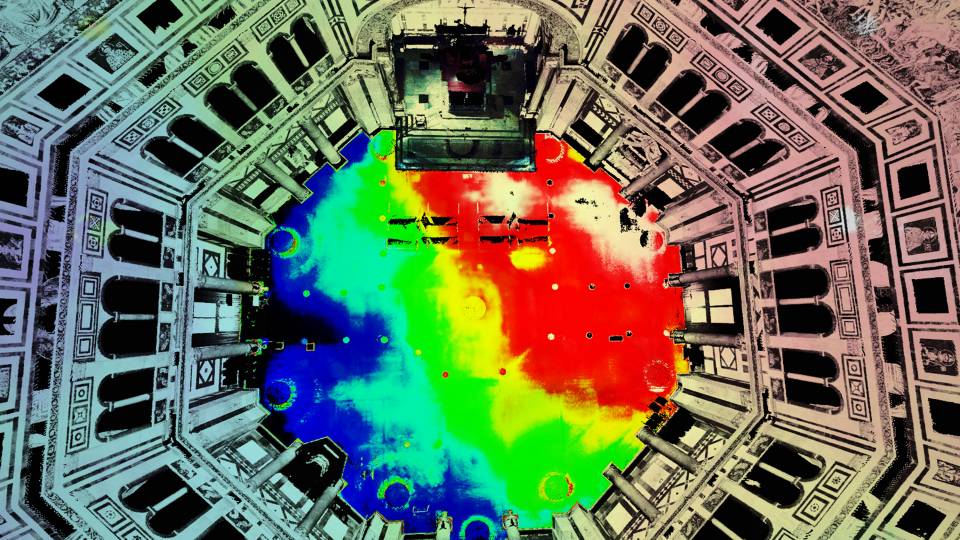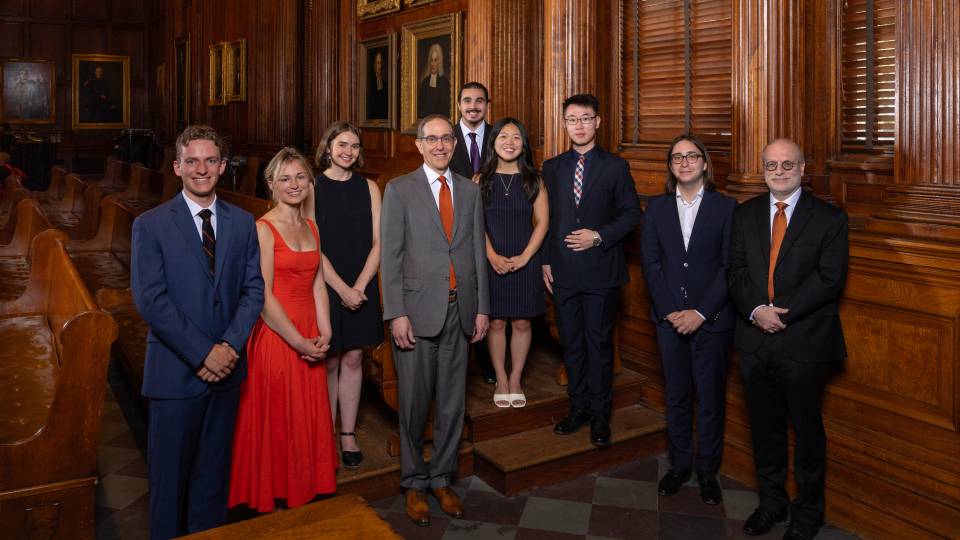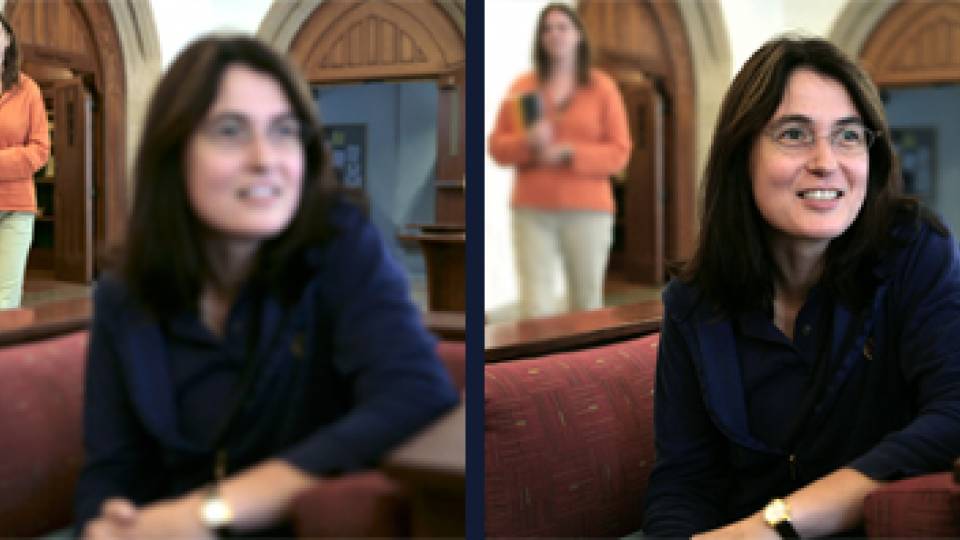Princeton Senior Gabbie Acot (left) discusses her senior thesis exploring the reconstruction of traumatic head injuries with advisers Annegret Dettwiler-Danspeckgruber, principal investigator at the Neuroscience of Traumatic Brain Injury Research Laboratory at Princeton Neuroscience Institute (center), and Branko Glišić, associate professor of civil and environmental engineering (right). Acot combined her interests in medicine, engineering and neuroscience, offering a promising approach to understanding how the brain is injured during a concussive hit.
Gabbie Acot started off on a pre-med track at Princeton before broadening her studies to include structural engineering and then neuroscience. Her senior thesis project brought together all of these interests, combining video analysis, neuroimaging and numerical modeling to perform a forensic reconstruction of college football head impacts.
Acot’s adviser called her project “very Princetonian” because of its mix of engineering and the natural sciences. “I always consider Princeton as almost a neo-Renaissance place where you have scholars who are both engineers and artists in a sense, and I think her work is fitting this very well,” said Branko Glišić, associate professor of civil and environmental engineering.
Acot’s research scientifically reconstructed head impacts to explore the mechanics of football concussions as a pathway to understanding, identifying and preventing the injuries.
Acot analyzed case studies of two Princeton University football players. She studied videos to reconstruct the mechanics of head impact events and calculated biomechanical metrics using a numerical engineering technique called the finite element method.
Comparing the biomechanical data with data and calculations from neuroimaging, Acot found that they correlated well and suggested areas of improvement within the accident reconstruction and finite element simulation processes. She believes that researchers can improve the processes by which head impact accidents are simulated to eventually use this tool for diagnostic and prevention purposes, even on football field sidelines.
What stands out about Acot’s project is the originality of the application, said Glišić. He noted Acot combined analysis of the velocity of the hits from game videos with finite element modeling to understand the mechanical stress and deformation the impacts deliver to the brain. She then reviewed diffusion tensor images (DTI), derived from an advanced magnetic resonance imaging (MRI) technique to assess whether there is a relationship between these high stress and strain zones and the structural differences in the deep white matter of the brain previously identified in the DTI images.
“I find it quite advanced,” said Glišić, who also credited Acot for analyzing concussions from multiple, smaller hits, which are harder to diagnose. “This is an area in concussion research that is, as of now, not fully understood.”
Acot’s idea for her thesis took shape while studying at University College Dublin during her junior year. She worked with Michael Gilchrist, a professor of mechanical engineering, who was researching rugby player and equestrian rider head impacts using finite element modeling, and became one of Acot’s advisers. “All throughout Princeton, I never really knew how to combine my interest in civil engineering and medicine,” said Acot. “This was the first time that I saw an intersection of both.”
When she returned to Princeton, Acot discussed her thesis idea with Glišić. Then she did a Google search for “Princeton concussion” and found articles by Annegret Dettwiler-Danspeckgruber, principal investigator at the Neuroscience of Traumatic Brain Injury Research Laboratory at Princeton Neuroscience Institute. Acot sent her an email, seeking advice. “She ended up being my adviser,” said Acot. “I wasn’t even expecting an answer because I was just a random senior emailing her.”
Acot said one of her biggest challenges was coordinating three advisers from different disciplines in different countries. “The way we came together was kind of magic,” said Acot.
Noting it is rare for an undergraduate to have three advisers, Glišić praised the multidisciplinary approach of Acot’s thesis, comparing it to what the National Science Foundation calls convergence research.
Gilchrist, a third adviser, agreed. “This project would have been challenging for even a good Ph.D. student, but Gabbie relished the challenge of learning and mastering these advanced topics,” said Gilchrist, adding Acot’s project has laid the groundwork for future collaboration among the three advisers.
Another challenge was obtaining Institutional Review Board (IRB) approval for the project so Acot could access video footage from Princeton football games. The IRB, which oversees research involving human subjects, granted approval in November 2020. To find football players for her project, Acot received support from Dettwiler-Danspeckgruber, who has conducted research involving Princeton’s football team.
Dettwiler-Danspeckgruber said Acot’s thesis is a promising approach to increase understanding of how the brain is injured during a concussive hit, and could eventually serve as a diagnostic tool.
“Gabbie is a unique and admirable individual, and I have been very impressed by her perseverance to gain access to the necessary data allowing her to carry out the accident reconstruction and, in addition, to assimilate the basic knowledge of how to view DTI images, a skill that was novel for her,” said Dettwiler-Danspeckgruber, who was also the second reader of the thesis. “Gabbie’s thesis required her to expand her primary field of study in engineering to the one of neuroscience, more specifically neuroimaging, and she handled this aspect of her thesis with serious scientific purpose and great ease.”
The three advisers hope to shape Acot’s research into a journal article, according to Glišić.
Acot, of Maywood, New Jersey, wants to be a pediatrician. After graduating from Princeton, she will work as a research assistant at the University of Texas MD Anderson Cancer Research Center in Houston in the lab of David J. Tweardy, Class of 1974, head of the internal medicine division at MD Anderson, to gain research experience before applying to medical school.
Reflecting on the job she found in Tweardy's lab and the assistance she received from advisers on two continents, Acot said her thesis project taught her people are willing to help. “It says a lot about collaboration over multiple barriers, such as time zones and countries and institutions. I’ll always remember that,” she said. “I can ask for help and create something even greater than I could have accomplished on my own.”






